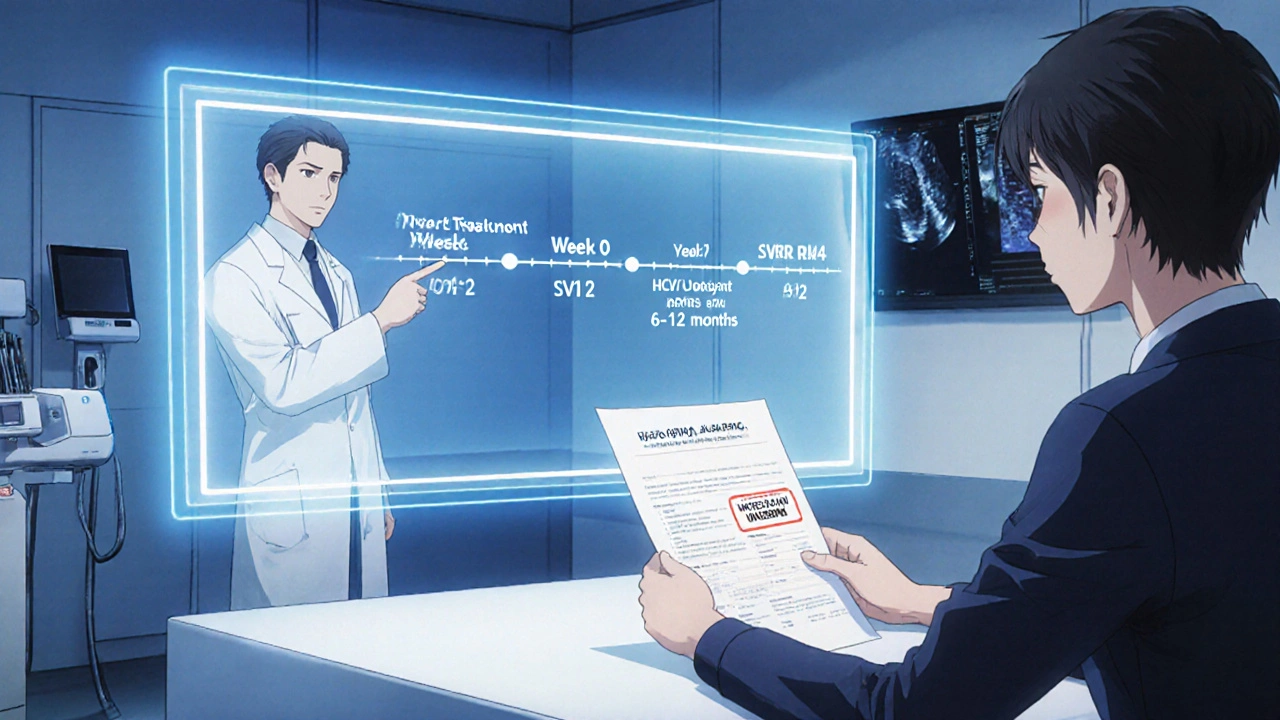Hepatitis C Post-Treatment Monitoring Tracker
Set Your Treatment End Date
Based on guidelines from the American Association for the Study of Liver Diseases (AASLD), here's your personalized monitoring schedule.
| Time Point | Tests / Assessments | Purpose | Status |
|---|
Finished a course of Ledipasvir and wondering what comes next? Most patients think “I’m done, right?” but the real work starts after the pills are finished. Proper post‑treatment care and monitoring can mean the difference between a lasting cure and a silent relapse.
What is Ledipasvir and why does post‑treatment care matter?
Ledipasvir is a direct‑acting antiviral (DAA) that blocks the NS5A protein of the hepatitis C virus (HCV). It is usually combined with sofosbuvir in a single tablet and prescribed for 8‑12 weeks depending on genotype and liver condition. The drug’s cure rates exceed 95 % when patients complete the regimen, but the virus can linger at low levels, and the liver needs time to heal.
Because HCV can hide in liver cells, clinicians rely on Ledipasvir post-treatment monitoring to confirm a sustained virologic response (SVR) and to catch any early signs of relapse.
Key monitoring milestones after finishing Ledipasvir
Most guidelines, including those from the American Association for the Study of Liver Diseases (AASLD), recommend a schedule of blood tests and clinical check‑ins. Below is a typical timeline, but your doctor may adjust it based on your genotype, baseline fibrosis stage, and any co‑medications.
| Time Point | Tests / Assessments | Purpose |
|---|---|---|
| End of Treatment (Week 0) | HCV RNA PCR, ALT/AST, complete blood count (CBC) | Baseline for post‑therapy comparison |
| Week 4 | HCV RNA PCR | Early detection of relapse |
| Week 12 (SVR12) | HCV RNA PCR, liver function tests (LFTs), fibrosis assessment (FibroScan or APRI) | Primary cure endpoint - sustained virologic response |
| Week 24 (SVR24) | HCV RNA PCR, LFTs | Confirm durability of cure |
| 6‑12 months (optional) | Ultrasound, alpha‑fetoprotein (AFP) if cirrhosis | Surveillance for hepatocellular carcinoma (HCC) |
The most crucial checkpoint is SVR12 - an undetectable viral load 12 weeks after treatment. Achieving SVR12 is considered a cure in >95 % of cases.
Understanding the lab values you’ll see
When you get your results, you’ll encounter a handful of acronyms. Here’s a quick cheat‑sheet:
- ALT (alanine aminotransferase) - Elevations suggest liver inflammation. Normal ranges are 7‑56 U/L.
- AST (aspartate aminotransferase) - Works with ALT to flag damage.
- HCV RNA PCR - Detects viral genetic material. An ‘undetectable’ result means Sustained Virologic Response (SVR) has been achieved.
- Fibrosis stage (F0‑F4) - Assessed by FibroScan, APRI score, or biopsy. Moving from F3/F4 to a lower stage after SVR is a good sign of liver recovery.
Any spike in ALT/AST after treatment should be discussed with your clinician, especially if you have underlying fatty liver disease or alcohol use.

Managing residual symptoms and lifestyle tweaks
Even after a virologic cure, some patients report fatigue, mild abdominal discomfort, or joint aches for a few weeks. These are usually post‑viral inflammation rather than treatment toxicity, but they deserve a plan.
Consider these practical steps:
- Hydration and balanced nutrition - Aim for at least 2 L of water daily and a Mediterranean‑style diet rich in omega‑3 fatty acids, vegetables, and whole grains.
- Exercise - Light aerobic activity (30 minutes, 5 days a week) improves liver blood flow and reduces fatigue.
- Alcohol moderation - Even after cure, excessive alcohol can reignite fibrosis. Keep intake below 14 units per week.
- Weight management - If you’re overweight (BMI > 25), aim for a 5‑10 % reduction; this can reverse early fibrosis.
- Vaccinations - Get vaccinated against hepatitis A and B if you haven’t already; co‑infection can worsen liver health.
These measures help the liver regenerate and lower the risk of future complications such as hepatocellular carcinoma (HCC).
When to call your doctor
Most post‑treatment concerns resolve on their own, but certain red flags require immediate medical attention:
- Persistent jaundice (yellowing of skin or eyes) after week 4
- Sharp right‑upper‑quadrant pain that doesn’t improve
- Sudden, unexplained weight loss >5 % over a month
- New rash, fever, or severe fatigue lasting more than two weeks
- Elevated ALT/AST >3 × the upper limit of normal on two consecutive tests
Contact your hepatology clinic or primary care provider promptly if any of these appear. Early intervention can prevent irreversible liver damage.
Special considerations for certain patient groups
Not everyone follows the same schedule. Here’s how specific populations may need extra attention.
- Cirrhotic patients (F4) - Continue imaging (ultrasound) every six months for HCC surveillance, even after SVR.
- People with HIV co‑infection - Coordinate antiretroviral therapy; drug‑drug interactions can affect both viral loads.
- Kidney‑impaired individuals - Monitor creatinine and eGFR; dose adjustments are rare with Ledipasvir but still prudent.
- Pregnant or breastfeeding women - Current guidelines advise against DAAs during pregnancy; post‑treatment follow‑up focuses on infant health.
Putting it all together: a quick checklist
- Mark your calendar for SVR12 and SVR24 blood draws.
- Keep a log of any new symptoms, even mild ones.
- Maintain a healthy diet and limit alcohol.
- Schedule an abdominal ultrasound if you had cirrhosis before treatment.
- Know the emergency signs that warrant a call to your doctor.
By following this roadmap, you give your liver the best chance to bounce back fully.
Frequently Asked Questions
Can the virus come back after an undetectable SVR12?
Relapse after a confirmed undetectable HCV RNA at week 12 is rare (<1 %). Most re‑appearances are due to reinfection from new exposure, not treatment failure.
Do I need another course of Ledipasvir if I relapse?
If relapse is confirmed, resistance testing guides the next regimen. Often, a different DAA combination (e.g., glecaprevir/pibrentasvir) is prescribed.
How long does it take for liver enzymes to normalize?
ALT and AST levels typically drop to normal within 4‑12 weeks post‑treatment, but those with advanced fibrosis may take longer.
Is it safe to travel after finishing Ledipasvir?
Yes, provided you have your SVR test results and a copy of your treatment record. Keep hydrated and avoid excess alcohol while traveling.
Should I still get vaccinated for hepatitis A and B?
Vaccination is recommended for anyone cleared of HCV, especially if you have liver scarring, to prevent new infections.
Remember, the goal after Ledipasvir isn’t just to finish the pills-it’s to stay virus‑free and keep your liver healthy for the long haul.
